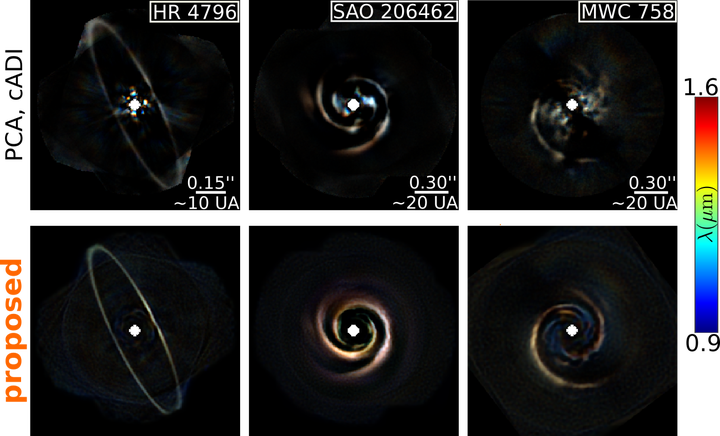Multispectral Image Reconstruction of Faint Circumstellar Environments from High Contrast Angular Spectral Differential Imaging (ASDI) Data
SPIE Astronomical telescopes + instrumentation
 Reconstruction examples of the circumstellar environment obtained with the proposed algorithm (REXPACO ASDI) comparatively to methods (cADI, PCA) applied routinely in the field.
Reconstruction examples of the circumstellar environment obtained with the proposed algorithm (REXPACO ASDI) comparatively to methods (cADI, PCA) applied routinely in the field.
Abstract
We recently proposed REXPACO (Flasseur et al., 2021, A&A A62), an algorithm for imaging circumstellar environments from high contrast Angular Differential Imaging (ADI) data. In the context of high contrast imaging where the signal of interest is largely dominated by a nuisance term due to the stellar light leakages and the noise, our algorithm amounts to jointly estimating the object of interest and the statistics (mean and covariance matrix) of the nuisance component. By also taking into account the instrumental point spread function (PSF), our algorithm yields a deblurred estimate of the object of interest without the artifacts resulting from other methods. In this contribution, we investigate means to extend REXPACO. We first review the main components of the algorithm and propose to use an alternate model for the covariance matrix of the nuisance component. We show that this choice yields similar performances as with the patch-based model with shrinkage assumed in the original method. This alternative model opens new possibilities to account for the correlations, which is a key point to eliminate the artifacts. Besides, we show how the original algorithm can be modified to deal with Angular Spectral Differential Imaging (ASDI) data and restore deblurred multispectral images of the circumstellar environment. We apply this modified version of REXPACO on several ASDI data from the SPHERE-IFS instrument and we show that the proposed method significantly reduces the typical artifacts produced by state-of-the-art algorithms.